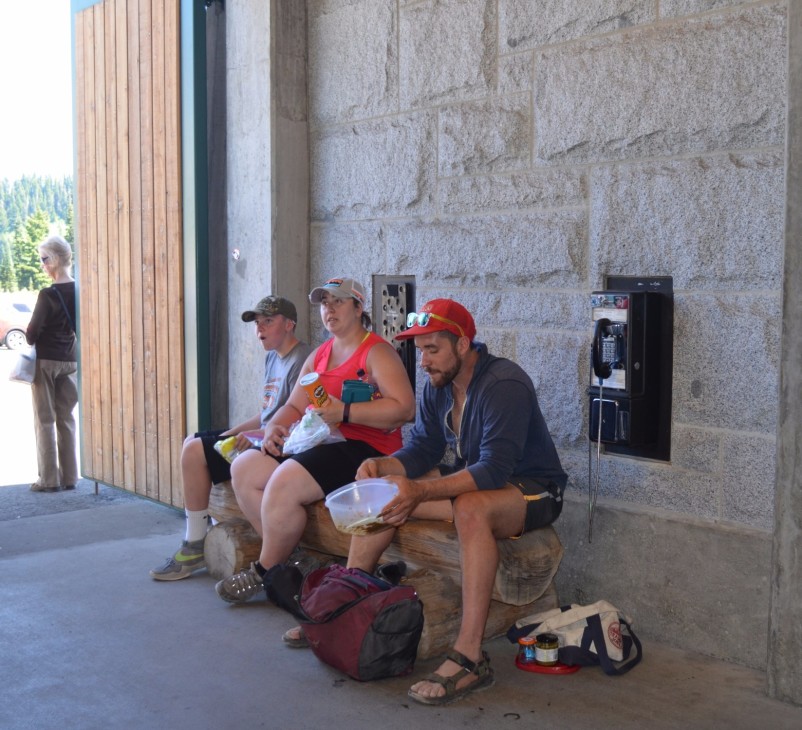Update: As of May 22, 2018, the National Park Service said it has authorized Verizon and T-Mobile to provide coverage. Eventually AT&T may also provide cell service.
The Jackson Visitor Center at Paradise is where most people come first when they visit Mount Rainier National Park. Even on this Tuesday afternoon, the parking lot is full, and cars are parked one after another down the road.
Right now, the only way to make a phone call from the visitor center is to use one of a couple of pay phones. But, soon, there might be cell service out here if a proposal to install antennae in the building goes through.
The park would be following in the footsteps of Yellowstone and other national parks that already have cell coverage. But some people are fighting the proposal, arguing that calling and texting would ruin the solitude that draws people to the mountains in the first place.
“It kind of takes away from the experience of not having cell service up here,” says Danny Adams, a teenager from Tacoma.
Sanne Beavin and Carol Snyder, friends from Gig Harbor, agree that using cellphones could detract from experiencing the wilderness.
“You don’t want people having arguments with their parents,” Snyder says.
But not everyone’s opposed. On a hiking trail close to Paradise, Bonnie Lemon was pleased to hear there could soon be service.
“I own my business, and I could be up here running my business and hiking at the same time,” she explains, “which would be awesome.”
Similar debates have played out across the country whenever a phone company approaches a national park about cell coverage.
At Mount Rainier National Park, Verizon Wireless proposed installing cell antennae two years ago. Since then, park employees have been looking at whether or not there’s a way to provide cell service without changing the character of the park. What they came up with was installing antennae inside the Jackson Visitor Center, hidden from view.
“The coverage would be principally in the Paradise developed area,” says Randy King, the superintendent of Mount Rainier National Park. He’s the one who’s going to make the final call about coverage. “You know, those signals are blocked by topography, so it wouldn’t go beyond ridge lines” — so only the most developed areas would get cell service.
That means this isn’t going to connect people throughout the park's backcountry or remote slopes to 911; hikers and climbers might get lost or injured on the other side of the mountain, where there still wouldn’t be service.
Rob Smith, with the National Parks Conservation Association, says it’s more about convenience.
“To some degree, we simply accept that here we are in 2017 and almost everyone has cellphones to get around, to learn if the lodge is open, to communicate with each other,” Smith explains. “That’s just kind of the way we get there in the same way we get there in motorcars instead of horse-drawn wagons.”
The public had a chance to weigh in on the proposal this summer. Mount Rainier National Park’s environmental coordinator, Karen Thompson, published an environmental assessment and opened it up for public comments.
She says the park usually gets about 20 comments on an average proposal. Once, she got about 200 comments on a proposal to raise entrance fees.

On this proposal, “I’ve received 800 plus roughly another 100 that were form letters from Verizon employees,” Thompson laughs.
Thompson says most of the comments were in opposition to cell service at Mount Rainier. The main argument she’s seen is that people go to parks for solitude, and cellphones would interfere with that.
Back at the Visitor Center at Paradise, Carol Snyder and Sanne Beavin have talked themselves into changing their minds.
“If people would be respectful and only use it for emergencies or navigation, I think that would be OK,” Snyder says.
“If you place notice that there are fines if you use them except for what Carol just said,” Beavin agrees, “maybe that’s the answer.”
The question of whether or not cell service belongs in the national parks is not likely to go away anytime soon. Olympic National Park is fielding a similar request for coverage. In fact, Verizon says it hopes to get cell service in all the national parks.
Eilís O'Neill from KUOW/EarthFix produce this story. The video was produced by Ken Christensen from KCTS9/EarthFix.



